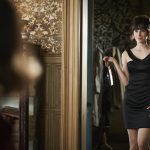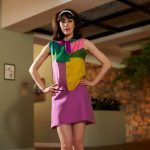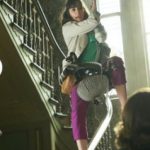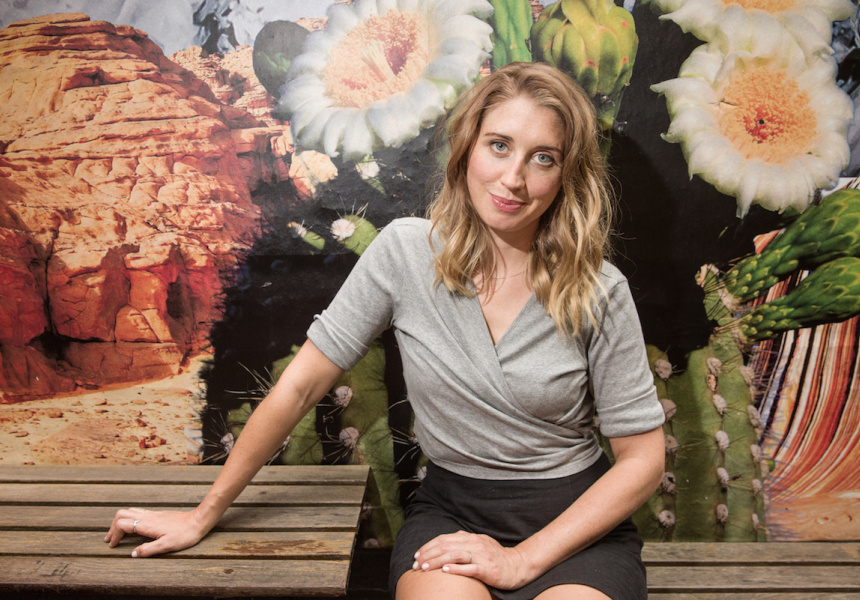In the lead-up to the 26th Scarlet Stiletto Awards on 23 November, Carmel Shute, Secretary of Sisters in Crime, spoke to designer Maria Pattison about the costuming of Peregrine Fisher for Ms Fisher’s MODern Murder Mysteries. Geraldine Hakewill, who plays Peregrine, is presenting the awards.
The series is set in 1964 when Peregrine Fisher, the niece of the famous twenties’ sleuth Phryne Fisher (whose plane has disappeared over New Guinea), is suddenly trust in the role of sleuth. While Phryne Fisher (Miss Fisher’s Murder Mysteries) was a twenties’ fashion icon, it wasn’t simply a matter of Peregrine fitting her aunt’s very stylish shoes.
Phryne was a fashion icon of the twenties. Was Peregrine designed to be an icon of the sixties?
It was important that Peregrine didn’t simply step into Phryne’s world and fill her shoes. Instead it was a bit more of a journey towards finding her place in the world, and in the Adventuresses’ Club in which Phryne had been a member. She is introduced as a youthful, small-town girl living in a caravan in Perth and working in a hairdressing salon. She knows something of youth fashion – with shorts and a modern bikini – but her style matures as the series develops.
 By the end of the first telemovie she is gifted a ‘little black dress’. The moment of ‘the big reveal’ – where she appears in the doorway, may be a nod to Givenchy’s LBD, worn by Audrey Hepburn, but more importantly, it’s where we first glimpse Peregrine’s potential for adopting a more sophisticated look. In this sense, the design had to play to Peregrine’s youthful, free-spirit but also to her on-going transformation, or journey, to becoming a professional and confident private detective, as was her aunt.
By the end of the first telemovie she is gifted a ‘little black dress’. The moment of ‘the big reveal’ – where she appears in the doorway, may be a nod to Givenchy’s LBD, worn by Audrey Hepburn, but more importantly, it’s where we first glimpse Peregrine’s potential for adopting a more sophisticated look. In this sense, the design had to play to Peregrine’s youthful, free-spirit but also to her on-going transformation, or journey, to becoming a professional and confident private detective, as was her aunt.
Throughout the sixties, new looks were exploding onto the scene. The narrative of fashion became a narrative of women’s empowerment. Industrial changes in terms of garment manufacture allowed for more globalized trends. While the elegance of the fifties carried into the sixties, ready-to-wear meant people were able to choose things off the rack and create their own style. In this, access to fashion and trends meant access to a movement, and therefore what we see in the styles that came out of the sixties is the zeitgeist of the era.
Peregrine is very-much exploring this politic as her engagement with fashion materialises simultaneously with her sense of identity and confidence as the telemovies develop.
Can you explain you research and design process? Where did the ideas come from and how extensive was the research?
Creating the overall look involved more than researching sixties’ fashion though I did plenty of that. I spent a couple of weeks before pre-production researching films, popular culture, and fine art as well as fashion shoots, models, fashion houses and catalogues – the works! The sixties were an era of immense change. It began with Jackie Kennedy and Audrey Hepburn, progressed into Mary Quant and the youthquake movement. After 64’ we had Paco Rabbane, Op-Art and psychedelia until we got to the hippie movement – what a time!
What came out of the research was a concentration of what 1964 looked like in terms of shape, structure, silhouette and detail – and that meant omitting a lot of what came after. We developed a strong colour palette based on the referencing, and that involved colour research relating to abstract expressionism of the time and advertising and print media as well as colour trends in fashion.
 Where did you source the costumes and accessories? Were some things hard to find?
Where did you source the costumes and accessories? Were some things hard to find?
With a large cast of characters and hundreds of looks to create for various extras across the four telemovies, we needed a good stock of sixties’ clothing. Access and availability are limited in Australia, especially for early sixties’ clothing and accessories in good condition. Here in Australia women wore their capris to death! Authentic, good quality coats and MOD pieces were hard to come by. While we relied on vintage collections such as the beautiful Vintage Clothing, based out of Fox studios, for special pieces, a majority of the stock was hand-picked from costume rental houses in Los Angeles. Access to original pieces and curated collections allowed us to really stick to a true colour palette.
Another hugely important element was access to sixties’ fabrics that we sourced from local collectors and but mainly from fabric stores in L.A. with a huge range of authentic originals that had the colour and structure we needed.
Almost every garment worn by Peregrine was made in-house. The suits for Detective James Steed were tailor made with fabric from L.A. All of the specialty looks, such as the bridal parade at the beginning of the first telemovie, were designed and then made in-house also, though some of the silk was laser-cut, rather than hand-cut, making the process slightly less labour intensive.
Apart from those, we were very lucky to have unique pieces come from unexpected places. Even small vintage fairs in Melbourne sometimes presented unique finds. We certainly looked high and low to find the right pieces.
 Were there any specific challenges in costuming Peregrine?
Were there any specific challenges in costuming Peregrine?
Well Geri is tall, especially in comparison to many of the original garments. This makes it a dream to dress her, yet also meant that (almost) everything had to be tailor made.
More specifically, the scripts involved a lot of action so we had to make multiple sets of the same outfits. Whether it was multiples for stunt doubles, or to cut holes in for the wires of the harnesses, or a set with more give for more action, Peregrine’s look had to fit what was scripted. In the third telemovie, Peregrine was to slide down a hill to a murder scene, so we had to have multiple versions of the costume as there is no time to wash and dry when you’re in the middle of the bush!
Any words of encouragement for those dressing up for the Phrock Up for Peregrine Competition at this week’s 26th Scarlet Stiletto awards?
While we revere the more iconic looks of the sixties, don’t be afraid to break the rules! Fashion of the sixties was, and should remain, political!
_____________________________________________________________________
Pattison was nominated for an AACTA Award for Best Costume Design for Berlin Syndrome in 2017 as well as for Partisan in 2015. In 2018 Pattison was nominated for an APDG award for her work on feature film Upgrade and has recently has been nominated for an APDG award for her work on Ms. Fisher’s MODern Murder Mysteries, with the awards taking place next month.
Maria Pattison will judge the Phrock Up for Peregrine competition at Sisters in Crime’s 26th Scarlet Stiletto Awards for best short stories presented by Geraldine Hakewill– 6 for 6.30pm Saturday 23 November at South Melbourne’s Rising Sun Hotel. Prizes include DVDs of Ms Fisher’s MODern Murder Mysteries and Wanted (starring Geraldine Hakewill and Rebecca Gibney), kindly donated (respectively) by Every Cloud Production and Matchbox Productions.
(Note: When Essie Davis, star of Miss Fisher’s Murder Mysteries, presented the 20th Scarlet Stiletto Awards, there was an extremely popular Frock Up for Phryne competition.)
Bookings for the 26th Scarlet Stiletto Awards close at 12 noon Wednesday 20 November: http://scarlet2019dinner.eventbrite.com
More info: Carmel Shute. Secretary & National Co-convenor: 0412 569 356; admin@sistersincrime.org.au; https://sistersincrime.org.au/event/26th-scarlet-stiletto-awards/; https://sistersincrime.org.au/
